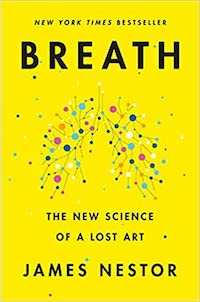Breath: The New Science of A Lost Art (James Nestor)
 (Amazon) “There is nothing more essential to our health and well-being than breathing: take air in, let it out, repeat twenty-five thousand times a day. Yet, as a species, humans have lost the ability to breathe correctly, with grave consequences.”
(Amazon) “There is nothing more essential to our health and well-being than breathing: take air in, let it out, repeat twenty-five thousand times a day. Yet, as a species, humans have lost the ability to breathe correctly, with grave consequences.”
“Journalist James Nestor travels the world to figure out what went wrong and how to fix it. The answers aren’t found in pulmonology labs, as we might expect, but in the muddy digs of ancient burial sites, secret Soviet facilities, New Jersey choir schools, and the smoggy streets of São Paulo. Nestor tracks down men and women exploring the hidden science behind ancient breathing practices like Pranayama, Sudarshan Kriya, and Tummo and teams up with pulmonary tinkerers to scientifically test long-held beliefs about how we breathe.”
I found this book absolutely fascinating. Some of my favorite bits:
Each inhaled breath provides us with new energy and each exhale releases old, stale energy.
(Breathing) is a force, a medicine, and a mechanism through which they could gain an almost superhuman power.
There are as many ways to breathe as there are foods to eat. […] Some methods of breathing will nourish our brains, while others will kill neurons; some will make us healthy, while others will hasten our death.
Hindus considered breath and spirit the same thing. […] Buddhists, who used breathing not only to lengthen their lives but to reach higher planes of consciousness.
Psoriasis could be reduced or reversed simply by changing the way we inhale and exhale. […] Changing how we breathe will help us live longer.
It takes the average person 3.3 seconds to inhale and exhale.
(On average) you will take 670 million breaths in your lifetime.
Forty percent of today’s population suffers from chronic nasal obstruction, and around half of us are habitual mouthbreathers.
Forty-five percent of adults snore occasionally, and a quarter of the population snores constantly.
In a single breath, more molecules of air will pass through your nose than all the grains of sand on all the world’s beaches.
“Mouthbreathing contribute(s) to periodontal disease and bad breath, and (is) the number one cause of cavities, even more damaging than sugar consumption, bad diet, or poor hygiene.” — Dr. Mark Burhenne
When breathing at a normal rate, our lungs will absorb only about a quarter of the available oxygen in the air. The majority of that oxygen is exhaled back out.
(The most efficient breathing rhythm) 5.5-second inhales followed by 5.5-second exhales, which works out almost exactly to 5.5 breaths a minute.
Breathing less is not the same as breathing slowly.
(Konstantin Pavlovich Buteyko) came to view the world as a mechanism, and everything within it as a collection of parts locking together to form a greater whole.
The only way to retain a slow resting heart rate is with slow breaths. […] The optimum breathing rate is about 5.5 breaths per minute. […] The perfect breath.
The deeper and more softly we breathe in, and the longer we exhale, the more slowly the heart beats and the calmer we become.
Eighteen percent of Americans suffer from some form of anxiety or panic.
(Yoga was once) a technology of breathing and thinking.
Prana is, basically an ancient theory of atoms. The concrete in your driveway, clothes on your body, spouse clanking dishes in your kitchen — they’re all made of swirling atomic bits. It’s energy. It’s prana.
When we breathe, we expand our life force. […] Infusing the body with prana is simple: you just breathe.
“All living organisms are but leaves on the same tree of life. The various functions of plants and animals and their specialized organs are manifestations of the same living matter.” — Albert Szent-Gyorgy
All matter is, at its most basic level, energy. […] What distinguishes inanimate objects like rocks from birds and bees and leaves is the level of energy, or the “excitability” of electrons within those atoms that make up the molecules in matter.
Breathing slow, less, and through the nose balances the levels of respiratory gases in the body and sends the maximum amount of oxygen to the maximum amount of tissues so that our cells have the maximum amount of electron reactivity.
“It could be that anxiety, at its root, isn’t a psychological problem at all.” — Justin Feinstein
